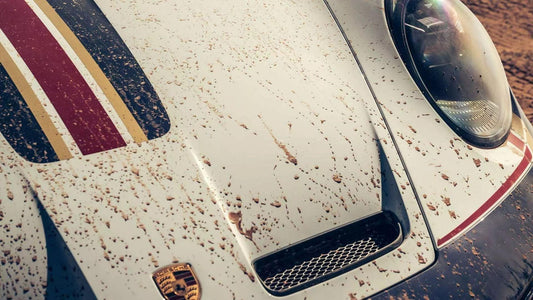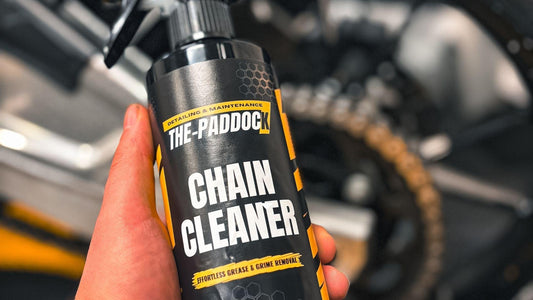Driving a motorcycle in winter, Red or Green light?
Motorcycling is a passion that for many ends in November or even October. For many, the passion for motorcycling means the thrill of the wind 'door' your helmet, the freedom of the road, and the unique connection with your machine. But when the temperatures drop, the days get shorter, and the first salt appears on the road, every motorcyclist faces the question: Do you keep riding or do you put your motorcycle in winter storage?
We take you into the special world of winter riding and tell you everything you need to know to make your motorcycle and yourself winter-proof. We also introduce a few smart solutions, such as our Ceramic Seal, which protect your motorcycle against winter hazards, so you can keep riding worry-free.

Why Ride a Motorcycle in Winter?
Let's be honest: riding a motorcycle in winter is not for the faint-hearted. But why would you want to? The answer is simple: it's a completely different experience. While summer is all about speed and the wind in your face, winter riding is about calmness, control, and purely enjoying the road. There are fewer people on the road, you can go to places that can be busy and crowded in summer, and the challenge makes it extra special.
In addition, there are many motorcyclists who simply have no alternative and use the motorcycle as their daily means of transportation. For them, the question is not whether they ride in the winter, but how they can do so safely and comfortably.
Where is the Border
The question of when to stop mainly depends on your personal preference and, of course, the circumstances. Not every winter day is the same: some days are dry, clear, and wonderfully fresh, while other days can be slippery, foggy, and treacherous. Here are some factors that determine whether you keep riding the engine or not:

- Temperature: Most riders find around the freezing point to be the limit. Below 0 degrees, it becomes more challenging due to the cold and the risk of frozen roads;
- Road conditions: As soon as there is snow or ice on the road, the risk becomes too great for many motorcyclists. Safety always comes first, and slippery roads are a no-go;
- Comfort: If you ride with good winter clothing, including heated grips and layers of thermal clothing, you can often handle the cold quite well. But if your fingers start to freeze or your visibility is impaired by fog, it can quickly become unpleasant;
- Brine: The enemy of every motorcyclist. Salt eats its way through your motorcycle, causing corrosion and rust. Later in this article, we explain how you can counteract this with products such as ourCeramic Seal.
The Preparation: Engine and Gear
If you decide to keep riding in the winter, you need to prepare not only yourself but also your motorcycle properly. Here are a few must-dos to ensure your motorcycle stays in top condition, even in the coldest months:
1. Winter tires for the Motorcycle?
Yes, winter tires are also available for motorcycles, and they can really make a difference in grip and control. Especially in low temperatures or wet conditions, winter tires provide more confidence. In the Netherlands, however, they are not mandatory, but in countries like Germany, they are;
2. Battery and Electronics
The cold is hard on your motorcycle's battery. Make sure your battery is in good condition and consider a trickle charger if you leave the motorcycle unused for an extended period. Also check the condition of your lights and electrical systems: in winter, you rely on good visibility and being seen.
3. Protect your Motorcycle against Road Salt
As we mentioned earlier, road salt is a huge threat to the lifespan of your engine. The salt on the roads causes metal parts to rust, and you want to prevent that at all costs.

A great solution for this is ourCeramic Seal. This product creates a protective layer over the paint and metal parts of your motorcycle, preventing road salt from taking hold. The Ceramic Seal ensures that dirt and salt are easier to rinse off, keeping your motorcycle looking like new for longer. A must-have for anyone who wants their motorcycle to shine year after year!
4. Clothing: Ensure Layers and Protection
Good motorcycle clothing in winter is your first line of defense against the cold. Think of thermal clothing, a windproof and waterproof layer, and a good helmet with an anti-fog visor. Heated gloves and grips are not a luxury. At temperatures below 5 degrees, it can quickly become too cold without these extras.
5. Rain and Water Repellency
Although rain is not exclusive to winter, it occurs more frequently in autumn and winter. Waterproof motorcycle clothing and rain covers for your luggage are essential.
What to do when it has snowed
Snow and motorcycling are usually not a good combination. Our advice will always be: take the car, go by bus or train.. Snow means slippery roads, reduced grip, and unpredictable conditions. If it is not strictly necessary, it is wise to leave the motorcycle parked for a day. The chance of slipping or falling is simply too great, even for experienced riders. When it snows, choose safety above all.

But if you do have to hit the road (or just like to take on that challenge), there are a few important things to keep in mind. Here’s what you need to do when there is snow:
Then make sure you drive super carefully. Drastically reduce your speed and be extra cautious with corners and braking. Try to drive in straight lines where possible, and use your brakes gently. Mainly brake with the engine instead of just the brake discs, to reduce the chance of locking up.
Check the road for dangerous spotsEven if there is only a thin layer of snow, there can be treacherous spots where ice or compacted snow causes problems. Pay extra attention to bridges, viaducts, and shaded areas, where the temperature can be lower and slipperiness occurs more quickly. Here, you want to drive extra slowly and attentively.
Tire pressure and grip
Slightly lower the tire pressure for more grip on the road when there is snow. With lower pressure, your tire can have more surface area on the road, which can help keep the motorcycle more stable. This is especially important if you do not have winter tires on your motorcycle.
Visibility Is Crucial
In snowy conditions, visibility is often limited for both you and other road users. Make sure to wear reflective clothing and always keep your lights on, even during the day. An extra set of bright LED lights can work wonders to be seen better, especially in heavy snowfall or bad weather.

Keep a Safe Distance
On snowy roads, your braking distance can be significantly longer, even at adjusted speeds. Therefore, keep much more distance than usual from other vehicles. This gives you more time to react if someone in front of you suddenly has to brake or slips.
Whether you decide to ride all winter long or temporarily store your motorcycle, make sure you take the right preparations. For those of us who keep riding, there is nothing better than a clear, cold winter day with an empty road ahead of you. However, make sure your motorcycle is well protected against both the cold and the salt. Our Ceramic Seal helps you with that and ensures that your engine looks tip-top all year round.
If there is snow on the road, our advice is always; especially leave the two-wheeler in the warm garage. Take the car, bus, or train, or as we can nowadays, work from home. Drive safely through the winter, so we can make 2025 a beautiful and shiny motorcycle year!
























